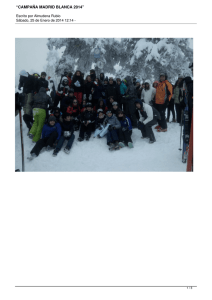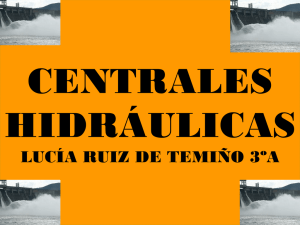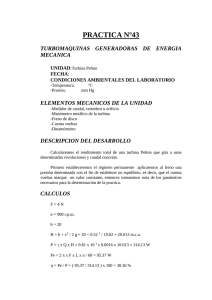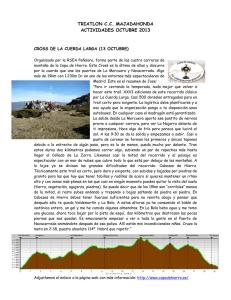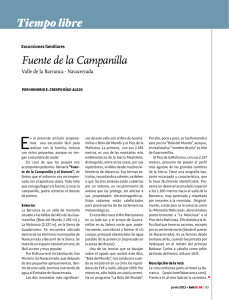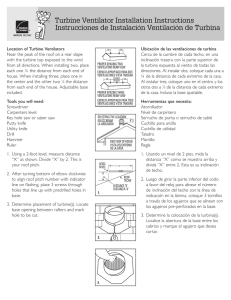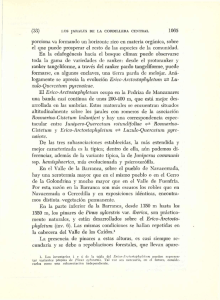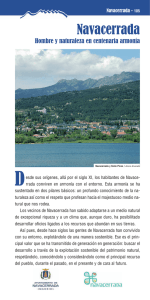proyecto de una mini central hidroeléctrica en el embalse de
Anuncio
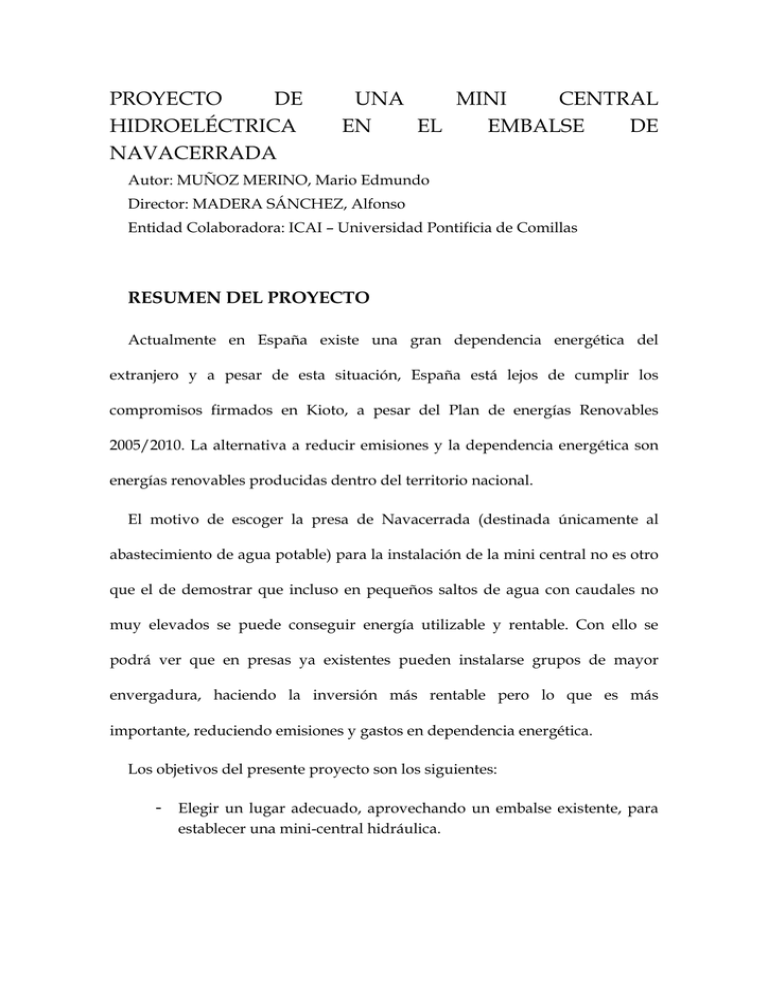
PROYECTO DE HIDROELÉCTRICA NAVACERRADA UNA MINI CENTRAL EN EL EMBALSE DE Autor: MUÑOZ MERINO, Mario Edmundo Director: MADERA SÁNCHEZ, Alfonso Entidad Colaboradora: ICAI – Universidad Pontificia de Comillas RESUMEN DEL PROYECTO Actualmente en España existe una gran dependencia energética del extranjero y a pesar de esta situación, España está lejos de cumplir los compromisos firmados en Kioto, a pesar del Plan de energías Renovables 2005/2010. La alternativa a reducir emisiones y la dependencia energética son energías renovables producidas dentro del territorio nacional. El motivo de escoger la presa de Navacerrada (destinada únicamente al abastecimiento de agua potable) para la instalación de la mini central no es otro que el de demostrar que incluso en pequeños saltos de agua con caudales no muy elevados se puede conseguir energía utilizable y rentable. Con ello se podrá ver que en presas ya existentes pueden instalarse grupos de mayor envergadura, haciendo la inversión más rentable pero lo que es más importante, reduciendo emisiones y gastos en dependencia energética. Los objetivos del presente proyecto son los siguientes: - Elegir un lugar adecuado, aprovechando un embalse existente, para establecer una mini-central hidráulica. - Estudiar la altura media del nivel del embalse y el caudal medio durante los últimos años para hacer estimar la potencia disponible y así dimensionar el equipamiento necesario. - Dimensionar en función de la potencia media estimada una turbina por semejanza, así como los elementos críticos de funcionamiento de la turbina y central. - Elaborar los planos de la instalación de la central. Comprobar que aun siendo pequeños el salto y el caudal, el proyecto sigue siendo viable y rentable. La central aprovechará el caudal que en un principio va destinado a la ETAP (Estación de Tratamiento de Aguas Residuales) de Navacerrada y que en la actualidad no produce ningún tipo de energía. Los cambios que originará será que habrá que hacer un by-pass a la turbina para el caso de que tenga que detenerse por mantenimiento. Para el cálculo de los parámetros nominales de la instalación se recurrió al histórico de caudales del rio Navacerrada, tomado de la Confederación Hidrográfica del Tajo y del histórico de alturas de la presa, facilitado por la ETAP de Navacerrada. A partir de las características hidráulicas de la presa, se tomó un modelo de una turbina que se sabe funciona bien para este tipo de saltos, y mediante leyes de semejanza se hallan las características de la turbina óptima (prototipo). Con los datos del prototipo, mediante un catálogo se escoge la que mejor se adapte a lo anteriormente calculado. A partir de la turbina escogida se dimensionan los diferentes elementos de la central como los espesores de la tubería forzada y la cámara espira; y las partes críticas de la turbina como pueden ser los ejes de los álabes del distribuidor Fink o el servomotor a utilizar. El eje del rodete será el del generador y el rodete y el eje irán acoplados mediante una chaveta. El generador es un tipo NIR3134A-4 de 270 kW de potencia nominal y la turbina entregará una potencia máxima de 210,79 kW. Por último se realiza un estudio sobre la viabilidad económica del proyecto en el que se estimó una inversión inicial de SETECIENTOS CINCUENTA Y SIETE MIL OCHOCIENTOS SETENTA euros (757.870 €), IVA incluido. A partir de la cantidad de energía generada al año, se calcularon los ingresos que serán de 139851,22 € en el primer año. Los gastos serán de 7578,71 € y corresponden a gastos de mantenimiento. El estudio de la rentabilidad dictaminó que el retorno de la inversión sucede al cabo de once años si la tasa de interés es del 12,5%y de ocho años si la tasa de interés es del 5%. Los plazos se encuentran dentro de los resultados habituales para este tipo de proyectos. PROYECTO DE HIDROELÉCTRICA NAVACERRADA UNA MINI CENTRAL EN EL EMBALSE DE Autor: MUÑOZ MERINO, Mario Edmundo Director: MADERA SÁNCHEZ, Alfonso Entidad Colaboradora: ICAI – Universidad Pontificia de Comillas Summary Currently, in Spain there is a high energy dependency on abroad, in spite of this situation, Spain is far away of complying with Kyoto standards and the 2005/2010 Plan of Renewal energies. The alternative for reducing the emissions and the energy dependency comes through renewal energy being produced within the Country. The reason why to select Navacerrada dam (whose only objective is to supply drinkable water) for the installation of the mini Central, is to demonstrate that even in small waterfalls with not a significative flow it can be achievable to get a usable and profitable energy. Thus, we can see that in already existing dams it can be installed groups of major wing span in order to make the investment more profitable, and what is more important, to reduce the emissions and expenses caused by the energy dependency. The targets of this project are as follows; - To select a suitable place for setting up a hydraulic mini Central taking into account an already existing. - To study the average height of the dam level and the average flow during the last years in order to estimate the available power and thus to dimension the necessary equipment. - To determine, based on the estimated average power a turbine and Central critical working elements - To elaborate the installation mapping of the Central. - To demonstrate that tough the fall and flow being small, the project keeps being achievable and profitable. The Central will benefit from the flow that at a beginning goes to the RWTS (Residual Water Treatment Station) of Navacerrada and that nowadays is not producing any type of energy. The only necessary update that it would be needed to make, is a by-pass at the turbine for when it has to be stopped due to maintenance reasons. For the calculations of the nominal parameters of the installation, we have gone to the historical flows of the Navacerrada river, taken from the Confederación Hidrológica del Tajo and the historical of heights at the dam provided by the Navacerrada RWTS. Based on the hydraulic characteristics of the dam and by applying to Resemblance Laws we came up to the characteristics of most suitable turbine (prototype). Once we have the prototype and through a catalogue we select the most suitable one to the previously mentioned calculations. With the turbine selected, we come to size the different Central elements such as the pipe thickness and the spiral chamber together with its critical parts, as it can be the blade axis of the Fink Distributor or the motor server to be used. The turbine axis will be the same one of the generator. The generator will be of the NIR3134A-4 type with a nominal power of 270 kW and the turbine will deliver a maximum power of 210,79 kW. Finally, it is being shown a study of the economic feasibility of the project based on; - An initial investment of SEVEN HUNDRED FIFTYSEVEN THOUSAND AND EIGHT HUNDRED AND SEVENTY euros. (757.870 €)), VAT included. - Incomes estimation of 139.851,22 € on the first year. - Expenses of 7578,71 € (mainly corresponding to maintenance). The profitability analysis shows that the Return of Investment is reached at a period of 11 years with an interest rate of 12,5% and at 8 years if a 5%. These periods are within the standard for these type of projects.
